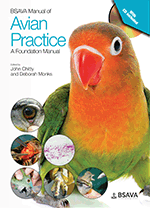
Full text loading...

Birds of any species are adept at disguising signs of illness. A commonly held belief is that sick birds are 70% dead when noticed by their owners and 90% dead by the time they are presented to the veterinary surgeon (veterinarian). This means that the majority of birds that are showing signs of illness require emergency, or at least same day, attention. This chapter provides guidance on the reception and triage of avian cases in the general practice.
Reception guide for the general practice, Page 1 of 1
< Previous page | Next page > /docserver/preview/fulltext/10.22233/9781910443323/9781910443323.8-1.gif

Full text loading...



















